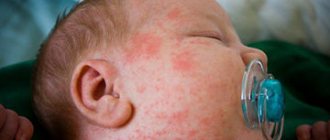Let's find out what diabetes mellitus is, what types of diabetes there are and their characteristics, why it appears in children and how it is dangerous for a growing body. And also what symptoms of the disease should alert parents, how to diagnose and treat the disease.
A diagnosis of diabetes in a child is always a surprise for parents and sounds like a death sentence. Their first reaction is denial.
However, alas, we have to realize: the child was struck by a “sweet” illness. Then comes a period of despair and the search for a magic cure. Unfortunately, it does not exist yet, but it is possible to achieve control over the disease.
We will talk about diabetes in children, the first warning signs and the dangers of this insidious disease.
What is diabetes mellitus?
It is a group of chronic incurable diseases of the endocrine system, characterized by a prolonged increase in blood sugar levels.
The disease develops due to the fact that glucose does not enter the cells. The changes are associated either with insufficient insulin production or with its improper functioning in the body.
Insulin: where does it come from and why is it needed?
Insulin is a hormone produced by special beta cells of the pancreas. Insulin is a kind of “key” that helps glucose penetrate through the wall into every cell of our body.
Main tasks of glucose
Serves as a source of energy or “fuel” for all processes occurring in our body: protein synthesis, production of hormones and enzymes, cell growth and renewal, transmission of nerve impulses and many others.
What happens if there is not enough glucose?
Cells begin to starve, which leads to disruption of the functioning of all organs and systems. At the same time, mechanisms for obtaining energy from one’s own tissues are launched: proteins and fats are broken down. This increases the formation of ketone bodies, which have a toxic effect on the body as a whole.
Useful video
The currently popular Marva Ohanyan shares her view on the development of diabetes and how to treat it at an early and late stage:
All parents, without exception, ask the question: is it possible to cure diabetes completely? It is impossible to completely get rid of diabetes. Parents of a child or teenager diagnosed with diabetes must understand the dangers of the disease and tell their child about it, but at the same time he must understand that he is no different from other children.
You cannot limit his communication with his peers and constantly talk about the fact that he is terminally ill. The child just needs to be told about the rules of eating, including outside the home, and taught how to administer insulin. He should always have the drug with him.
Compliance with all the rules of treatment and prevention guarantees the child a long life.
Why does diabetes occur?
The true causes of the disease have not yet been established, but the mechanisms that can trigger its development are known.
Heredity plays a significant role: there are abnormal genes that are passed on from parents to children. It is not the disease itself that is inherited, but the likelihood of its occurrence. For example, if a mother has type I diabetes, the risk that the child will also get sick is 1–5%, for the father - up to 4%, for both parents - 20%.
Abnormal genes can remain in a “sleeping” state for a long time, but one day they “wake up” and begin their destructive effect.
Predisposing factors can provoke the development of the disease:
* viral infections (rubella, measles, mumps, chicken pox);
* stressful situations (chronic\acute);
* autoimmune diseases (rheumatoid arthritis, systemic lupus erythematosus, etc.);
* chronic or acute pancreatitis;
* eating disorders, obesity and many others.
Fruits and berries
It is recommended to eat various fruits and berries in your diet, but they should not be sweet varieties (for example, apples, cherries, kiwi and many others).
Very rarely you can give children orange, tangerine, unsweetened strawberries, raspberries, blueberries and wild strawberries. As a rule, eating fruits is allowed in raw form, as well as in compotes (but they must be prepared only with a sugar substitute). It is important to exclude fatty, spicy and salty foods, sauces and gravies from the menu and diet. If children do not have any diseases associated with the liver or kidneys, then it is allowed to add moderate amounts to food in the form of seasonings, onions and salt. Children should eat at least 5-6 times a day and even more. Most often, children are satisfied only by eating food that is familiar to them. That is why, when composing a diet, it is necessary to take into account the peculiarities and stereotypes of the whole family’s diet, for example, the time frame and volumes of all meals, as well as the preferences and preferences of children. The correct use of food must be agreed only with the attending physician, whose baby is under supervision and is specially registered.
What is a “sweet” illness?
There are type I diabetes mellitus and type II diabetes mellitus. Despite similar symptoms, these are two completely different diseases.
Diabetes mellitus type I - insulin dependent
It most often affects children, but can develop at any age. Children under 5 years of age rarely get sick. Typically, the first symptoms appear at the age of 6–7 years, 10–11 years and 13–16 years are dangerous periods.
The most common hereditary inability of the beta cells of the pancreas to produce insulin.
An autoimmune process develops less frequently: under the influence of predisposing factors, the immune system ceases to “recognize” the beta cells of the pancreas and begins to destroy them.
Diabetes mellitus type II - non-insulin dependent
It affects mainly adults, but is rare in children.
With this form, cell walls become insensitive to insulin - the “key” stops working, so glucose does not penetrate the cells and accumulates in the blood. Moreover, the pancreas can produce insulin in both sufficient and insufficient quantities.
The main causes of childhood diabetes
It is common in society to think that the etiology of diabetes in a child comes down only to immune disorders, although this is absolutely not the case. In fact, there are a lot of sources of the formation of “sweet” illness. And today you will find out why children get diabetes.
All the reasons for the appearance of diabetes in newborns, preschool and school-age children, as well as in adolescents can be divided into two large groups:
- Diabetes mellitus type 1 (first) (autoimmune and idiopathic)
- Non-type 1 diabetes mellitus
The second group includes diseases and conditions that are not related to the functioning of the immune system. Now I will list the main ones, and later I will give a brief description. These forms of the disease account for up to 10% of all cases of childhood diabetes. If it is not type 1 diabetes, it may be:
- Diabetes mellitus type 2
- Diabetes MODY
- Neonatal diabetes (newborns)
- Diabetes mellitus accompanying genetic syndromes
At the diagnostic stage, it is very important to accurately diagnose and a special algorithm developed by WHO is used. I want you to know about it too. Diagnosing the last two forms is not difficult. But it can be difficult to differentiate the type of diabetes between first, second and MODY diabetes if a child has obesity. Below I provide a diagram of the algorithm for differential diagnosis in children and adolescents between the indicated forms of the disease and with concomitant obesity (click on the picture to make it larger).
Next, I will talk about each root cause in more detail, and at the end I will try to touch on the topic of the psychological foundations of the development of diabetes in children. Read to the end, it will be interesting...
Alarming symptoms: what to look for?
Some signs will help you suspect that something is wrong with your child.
Type I diabetes
It begins acutely, and the signs of the disease quickly increase:
* the child drinks a lot often, but his thirst is not quenched;
* frequent and large portions of urination;
* increased appetite;
* sudden weight loss - the child literally “melts” before our eyes, despite the fact that the appetite is increased;
* weakness, lethargy, drowsiness, decreased activity.
If you do not take immediate action and consult a doctor, diabetic ketoacidosis may develop.
Dangerous symptoms: smell of acetone on the breath (reminiscent of the smell of overripe apples), vomiting, abdominal pain, dehydration, confusion or loss of consciousness.
The situation is developing so quickly that you need to react almost instantly: call an ambulance. The disease does not allow time to “build up”: you do not need to wait until the next morning to donate blood in the laboratory on an empty stomach.
Type II diabetes
Signs of the disease increase gradually:
* fatigue;
* weight loss, despite increased appetite;
* thirst;
* frequent urination;
* frequent infections (ARVI\colds) and difficult wound healing (suppuration);
* blurred vision.
Blood sugar levels rise slowly, which does not allow all the symptoms of the disease to fully manifest themselves, so the diagnosis is often made late.
Symptoms
Symptoms of the disease:
- constant thirst and dry mouth even after drinking;
- frequent urination, while the color of the urine becomes lighter, and starchy traces remain on the underwear;
- mood changes: tearfulness, moodiness, depression;
- lethargy and fatigue even after a long rest;
- losing weight by eating too much;
- the appearance of purulent rashes on the body;
- non-healing wounds;
- nausea and vomiting;
- the appearance of an unpleasant aroma of missing apples or acetone from the oral cavity.
Biochemical blood test and rheumatic tests: norm and interpretation of indicators
Biochemistry - what will the analysis tell you? Why is it prescribed? When should my child see a doctor?
Read more about biochemical blood parameters.
In type I diabetes, blood sugar levels are initially quite high and increase rapidly over time. Usually the diagnosis is not in doubt.
If necessary, a sugar load test (glucose tolerance test) can be performed - for example, to diagnose type II diabetes or hidden carbohydrate metabolic disorders.
Proper treatment is the key to success and control over the disease!
Drugs are prescribed depending on the type of diabetes. Treatment is carried out throughout life.
Type I diabetes - insulin dependent
There is not enough insulin, but the body's cells remain sensitive to the hormone.
Insulin therapy begins immediately: drugs are distributed throughout the day in such a way that they imitate the insulin level of a healthy person. Doses are calculated individually for each child, depending on the severity of the disease and the degree of insulin deficiency.
Diabetes mellitus in children: rules of nutrition and new lifestyle
What is insulin-dependent diabetes type I, how to organize a child’s nutrition, why it is necessary to notify kindergarten and school about the disease, how to check and maintain blood sugar levels, whether vaccinations and physical activity are allowed - all the details are in our material.
Learn more about type 1 diabetes
Type II diabetes - non-insulin dependent
Glucose enters cells poorly or not at all, even if insulin levels are normal.
Drugs are prescribed whose action is aimed at improving the absorption of glucose by cells and slowing down the absorption of carbohydrates in the intestine.
Diagnosis of the condition
The most important sign of diabetes is a high concentration of glucose in the blood (more than 5.5 mmol/l). It is detected on an empty stomach; it is recommended to determine the indicator at least three times during the day. When hyperglycemia (high sugar) is detected, the mandatory examination includes blood tests for the level of:
- insulin,
- proinsulin,
- From peptide
- glycated hemoglobin,
- ketone bodies.
The urine is tested for sugar and ketone bodies, and if you have prediabetes, a glucose tolerance test may be required. To identify pathology of the pancreas, ultrasound is prescribed.
When determining the predisposition to the disease of a child born into a family of diabetics, or when there are difficulties in making a diagnosis, an immunological study of antibodies to cells that produce insulin and glutamate decarboxylase (GAD) is performed.











